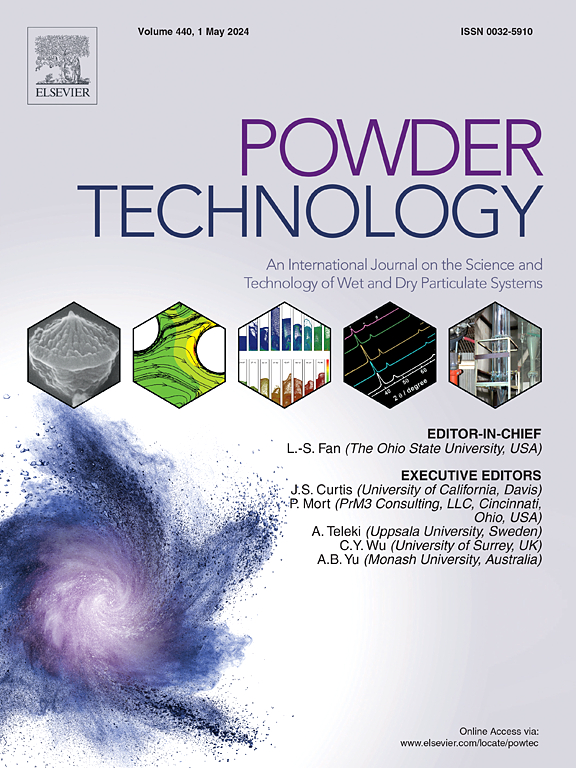Gas phase synthesis of mixed Cu1.8S-ZnS particles and the terminal phases in the reducing atmosphere
IF 4.5
2区 工程技术
Q2 ENGINEERING, CHEMICAL
引用次数: 0
Abstract
The synthesis of Cu₁.₈S, ZnS, and Cu₁.₈S-ZnS composite nanoparticles is achieved via reactive spray combustion, wherein rapid vaporization of thiophene initiates micro-explosions that promote high-temperature vapor-phase reactions under reducing conditions. High-resolution transmission electron microscopy (HRTEM) and X-ray diffraction (XRD) analyses reveal that the synthesized nanoparticles consist of agglomerated spherical primary crystallites, with average sizes of 12.2 nm for Cu₁.₈S, 10 nm for ZnS, and 10.8 nm for the Cu₁.₈S-ZnS composite. Elemental analysis via energy-dispersive X-ray spectroscopy (EDX) coupled with scanning transmission electron microscopy (STEM) confirms homogeneous spatial distribution of Cu and S in Cu₁.₈S, elevated surface oxygen content in ZnS attributed to physisorption, and substantial Cu incorporation into the ZnS lattice within the Cu₁.₈S-ZnS composite system. Structural analysis indicates that the contrast features observed in Cu₁.₈S, ZnS, and Cu-Zn mixed sulfides are consistent with their respective crystallographic symmetries, where sulfur atoms adopt well-ordered lattice positions, while copper exhibits partial site occupancy and electron density disorder attributed to the comparable ionic radii of Cu2+ and Zn2+ ions. This study underscores the efficacy of oxygen-deficient, reducing flame environments in facilitating the synthesis of binary and mixed-metal sulfide nanomaterials, enabling the formation of metastable phases providing a scalable, cost-effective route for producing advanced functional materials with broad application potential.

还原气氛中混合Cu1.8S-ZnS颗粒及其终相的气相合成
铜1的合成。₈S, ZnS, Cu₁。₈S-ZnS复合纳米颗粒是通过反应性喷雾燃烧获得的,其中噻吩的快速汽化引发微爆炸,在还原条件下促进高温气相反应。高分辨率透射电子显微镜(HRTEM)和x射线衍射(XRD)分析表明,合成的纳米颗粒由球状初生晶组成,Cu 1的平均尺寸为12.2 nm。₈S, ZnS为10nm, Cu₁为10.8 nm。₈S-ZnS复合。通过能量色散x射线能谱(EDX)和扫描透射电子显微镜(STEM)进行的元素分析证实了Cu₁中Cu和S的均匀空间分布。₈S,由于物理吸附,ZnS中表面氧含量升高,并且大量的Cu结合到Cu₁中的ZnS晶格中。₈S-ZnS复合体系。结构分析表明,在铜₁中观察到对比特征。₈S, ZnS和Cu-Zn混合硫化物具有各自的晶体对称性,其中硫原子采用有序的晶格位置,而铜表现出部分位置占用和电子密度紊乱,这是由于Cu2+和Zn2+离子的相似的离子半径。这项研究强调了缺氧、减少火焰环境在促进二元和混合金属硫化物纳米材料合成中的作用,使亚稳相的形成为生产具有广泛应用潜力的先进功能材料提供了一条可扩展、经济有效的途径。
本文章由计算机程序翻译,如有差异,请以英文原文为准。
求助全文
约1分钟内获得全文
求助全文
来源期刊

Powder Technology
工程技术-工程:化工
CiteScore
9.90
自引率
15.40%
发文量
1047
审稿时长
46 days
期刊介绍:
Powder Technology is an International Journal on the Science and Technology of Wet and Dry Particulate Systems. Powder Technology publishes papers on all aspects of the formation of particles and their characterisation and on the study of systems containing particulate solids. No limitation is imposed on the size of the particles, which may range from nanometre scale, as in pigments or aerosols, to that of mined or quarried materials. The following list of topics is not intended to be comprehensive, but rather to indicate typical subjects which fall within the scope of the journal's interests:
Formation and synthesis of particles by precipitation and other methods.
Modification of particles by agglomeration, coating, comminution and attrition.
Characterisation of the size, shape, surface area, pore structure and strength of particles and agglomerates (including the origins and effects of inter particle forces).
Packing, failure, flow and permeability of assemblies of particles.
Particle-particle interactions and suspension rheology.
Handling and processing operations such as slurry flow, fluidization, pneumatic conveying.
Interactions between particles and their environment, including delivery of particulate products to the body.
Applications of particle technology in production of pharmaceuticals, chemicals, foods, pigments, structural, and functional materials and in environmental and energy related matters.
For materials-oriented contributions we are looking for articles revealing the effect of particle/powder characteristics (size, morphology and composition, in that order) on material performance or functionality and, ideally, comparison to any industrial standard.
 求助内容:
求助内容: 应助结果提醒方式:
应助结果提醒方式:


